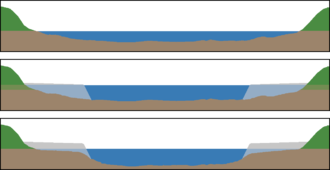navigability
With navigability , a body of water becomes a waterway on which shipping can be operated. A distinction is made between freight or passenger shipping and sport shipping . Navigability is increasingly in a field of tension with ecological requirements and nature conservation concerns, as set out in the European Water Framework Directive .
Responsibilities
In Germany, the Federal Waterways and Shipping Administration (WSV) is responsible for the navigability of the federal waterways . Among other things, it also classifies inland waterways on a scale from I to VII, see definition of classes . The federal states are responsible for the navigability of state waterways .
Temporary restrictions on navigability
One reason for the lack of navigability can be the insufficient water depth due to low summer water levels. Waters can also temporarily lose their navigability through obstacles such as floating debris or ice drifts. When ice forms , a thick ice sheet can bring shipping to a complete standstill.
Floods can also lead to a temporary loss of navigability, as large bank damage from swell or waves is to be expected. The flow velocity can also be increased, making maneuvering difficult. There is also the risk of large debris such as tree trunks; the headroom below bridges is reduced, and the landing stages and bollards could be flooded and thus inaccessible.
In most bodies of water, the level and thus navigability change regularly; While the level in tidal waters like the Lower Elbe changes twice a day, in the upper sections of the river these are mostly annual processes.
Web links
- Inland navigation OpenStreetMap Wiki
